“As a mother of two children, I put motherly love into every episode of ‘Robocar Poli,’ to tell my boys how important it is to help others and how much happiness they can get from it.”
So said Eum Jun-young, the director of the worldly-renowned animated children’s series “Robocar Poli.” The director has done everything for the animation series, from design to production.
The characters from her “Robocar Poli” have become some of the most-loved cartoon characters worldwide, as the show reaches more and more young audiences around the world.
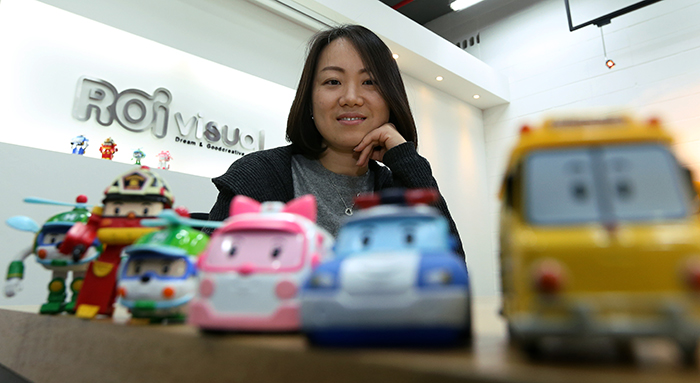
The cartoon was designed to help early childhood education, targeting kids from four years old to under seven years old. It features four main vehicles that transform into robots: the blue police car Poli, a red fire truck, Roy, a pink ambulance, Amber, and lastly, a green helicopter, Helly.
The team rushes to rescue kids whenever they get into trouble, like when there might be a traffic accident.
Since it was released in 2011 on EBS, an educational TV channel, seasons one and two of “Robocar Poli” have been released, each triggering a sensation among young viewers.
More than three years later, the show’s popularity has now crossed borders and has gone global. “Robocar Poli” enjoys a huge viewership in more than 54 countries, including France, Belgium, Switzerland, Japan, China, Russia and other European nations.
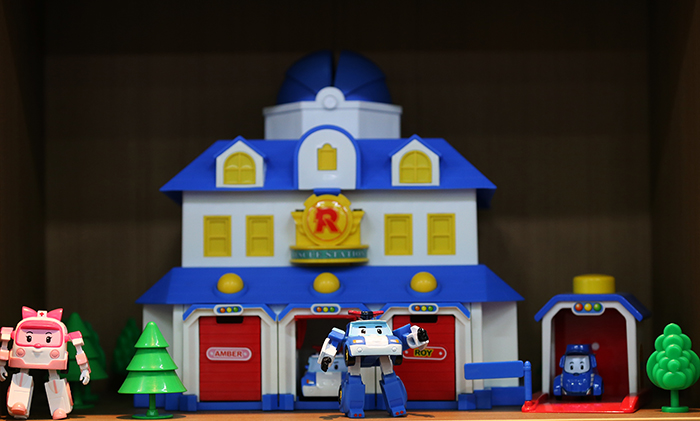
The animation series seems to prove the “sky-is-the-limit” theory. Its popularity worldwide has led to a series of associated products, from “Robocar Poli”-themed toys to musicals and even a theme park.
The birth of “Robocar Poli” dates back some 15 years, when Eum, still in her 20s, co-founded the production company Roi Visual with four other members she met in a cartoon club. After five years of toil, the team finally gave shape to the “Robocar Poli” characters.
“We started off in a rooftop office of only 16 square meters, so small we could have only three desktops,” said the director. “We pushed through so many trials and errors and, before we grew into what we are now, sometimes we just wanted to give up. We’ve been through everything. Now, we feel happy when we know our stories give hope and comfort to kids.”
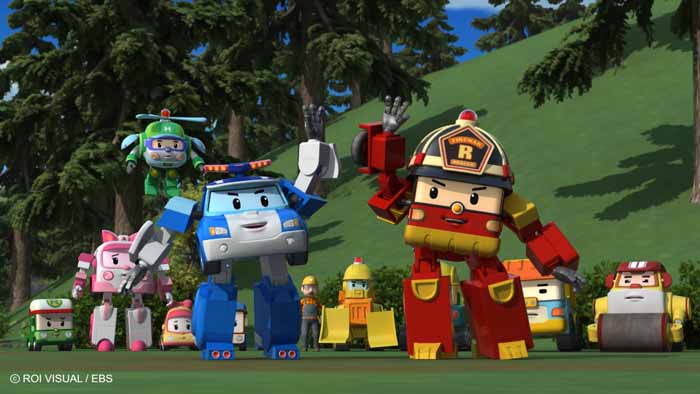
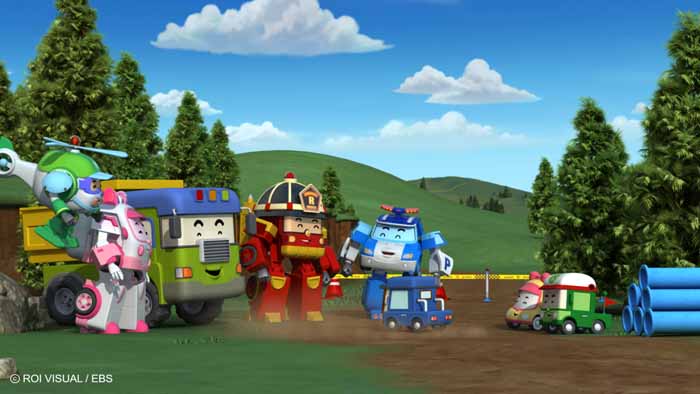
She recently got a piece of fan mail that enumerates a full list of questions the sender wants to know about “Robocar Poli.” Eum tries to respond to each piece of fan mail she receives.
“When I find someone like this admirer, who acknowledges my work as it is and notices that it is the result of all the sweat and blood we have shed, I realize that, yes, we are doing a good deed,” she said, with tears welling up in her eyes.
Season three begins broadcasting February 26 on EBS. Korea.net sat down with the director, who is spending her busy days preparing for the upcoming episodes, to hear more of her stories.
* Interview with director Eum Jun-young
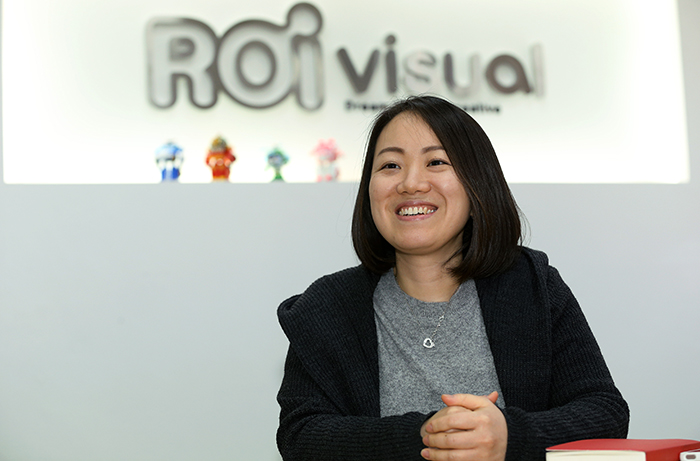
- How did you get into the animation industry? What elements of the medium made you decide to take this journey and make it your lifetime career?
When I was young, I was into drawing and dreamed of becoming a cartoonist or something. It wasn't like a, "Yes, I will definitely become a cartoonist," kind of dream, but I knew that drawing was what I really wanted to do for life. I didn't even major in animation. I couldn't shake off the desire to draw cartoons, a desire that comes from deep within.
As a freshman in college, I started thinking more specifically about, "What do I really want to do?" Many of my family members and friends around me, either the same age or older, often said that my imagination might be suited for cartoons. What they said helped me gather the courage needed to give it a try.
Taking advice from my friends, I once went to a workshop designed for cartoon lovers like me. There, for the first time, I learned how to use computer animation techniques to turn what I drew into something animated. I found it delightful to tell a story in the form of a cartoon, giving life to cartoons, and, especially, working with many likeminded people at the workshop. Up until then, I thought that drawing was something I had to do alone, but then I realized that it isn't. It can be something I work on together with others. As I took part in more projects with my team, I got more drawn into that.
From then on, I focused all my attention and energy on studying animated cartoons. I read each and every book I got my hands on, and attended cartoon clubs, as well. Some of the members I met there and I established the production company Roi Visual and we've been together ever since.
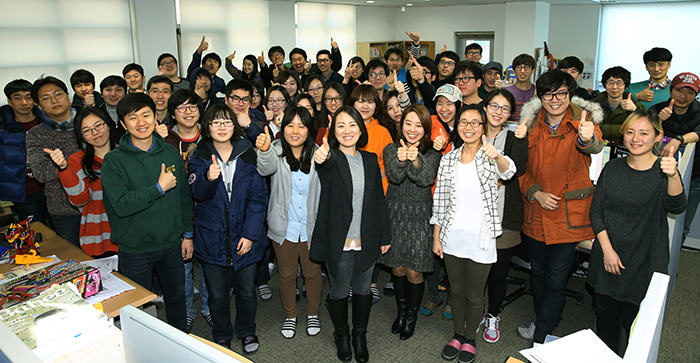
- Your 2011 creation "Robocar Poli" has garnered huge popularity in many countries, as well as here at home. What did you want to say with “Robocar Poli” to global young audiences?
These days, so many children have been left without parents, and many of them are forced to do too many things at a young age. They grow up without knowing important values that they should know. Parents, too, are not good at teaching their children such things as they grow up.
As a mother of two boys myself, I watched as my boys got into trouble and had difficulties communicating with their peers at school. I noticed that things grown-ups regard as "trivial" can be a big deal for kids. Understanding and listening to their problems is the most important thing to do as a parent, I thought.
One day, a certain idea came to mind: make an animated film that features transformable robotic cars. I thought it would be cool if cars that transform into robots could turn up to rescue children, like a hero as the kids get into dangerous situations. I've heard that the premise is an old cliché and that it might lose children's interest, but I believed that talking about everyday stories, made more interesting with robots, which most children are crazy about, might help change the way they think or might bring a solution and comfort to those in trouble.
By the time we started making these episodes, the best I could do as a mother was to tell a story relating to kids. I kept contemplating, "What elements are needed to draw a child’s eyes and to enliven my cartoons?"
I knew that most children are drawn to robots, as my boys are, and that if I had characters freely transform from cars to robots and vice versa, it would be fun. That's how “Robocar Poli” came to life.
I remember that many animated films coming to Korea at the time were tainted by too much violence or provocative scenes. Being a mother, I felt a strong sense of worry and shame knowing that my children might see that kind of stuff. I didn't want to let that happen, and thought that every parent would be of the same mind.
- We’ve heard that you first showed your boys “Robocar Poli” before bringing it to the world. How did they react?
They were instantly fascinated by it. It took a pretty long time to complete the work. It took more than five years, from planning all the way through to production. When my second son was two- or three-years-old, I began coming up with the idea, but when it was done, he was already past the appropriate age at which to watch it. I intended to make it for my son, but when it finally came out, my son, old enough to enter elementary school, found it boring.
- Where did the idea come from?
To be honest, the theme of cars transforming into robots has been around for many years, for example, the Japanese animation “Gundam” series from the 1970s and the more recent movie, “Transformers.”
I cannot say that such robotic characters have not affected me at all. Despite being a girl, I really loved robots, like “Gundam.” I would go into a sort of ecstasy when I played with robots.
As many of you know, robot toys are very difficult to transform. The too sophisticated parts make kids less happy when they’re playing with them. I was like, “How great would it be if I were to make robotic things with a simple structure and design that kids could easily play with?”
At the same time, I wanted to steer away from the long-standing image of violence or a battle between good and evil. Rather, I wanted to focus on designing a “friendly” robot doing good deeds, someone who delivers important values to the young audience and lets them know how rewarding it can be to help others.
I believed that if I planted a good and positive image into my robots, then they could encourage kids, who are usually crazy about robots, in the right direction.
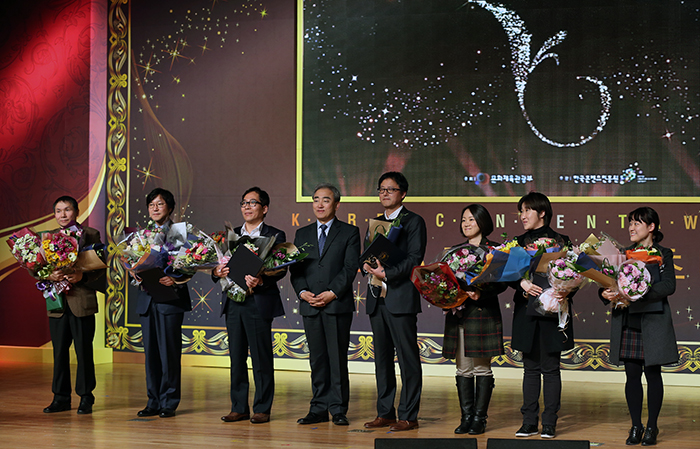
- You’ve so far focused on educational cartoons. Do you have any plans to expand into different realms?
I’ve been thinking about that a lot. Since its establishment in 1998, Roi Visual has put a lot of effort into bringing the production system up to the level it’s at now. We had to start from scratch. We did everything from the planning and producing through to the marketing, all by ourselves.
We will keep that pace, and we also hope to expand into more diverse territories. If given the chance, I’d like to create something that features unique characters and can be enjoyed by people of all ages and sexes.
- What do you think is the secret of “Robocar Poli” and why has it captured the hearts of young audiences everywhere, even in different cultures and languages?
I believe that any parent with kids is the same in any country. Also, all kids go through the same path as they grow up, no matter where they live. There is no difference in how they feel or in how they grow.
I realized this as I watched family-themed movies from other countries, wherein all the mothers and fathers hope their children will grow up healthy and the children all go through the same emotional and physical changes.
In that sense, I felt confident from the beginning that the “Robocar Poli” characters would strike a chord with both parents and kids alike.
- It must have taken a lot of thought and effort to create the characters. Where do you usually get your ideas from?
Usually, new ideas occur to me when I watch the kids around me growing up. Sometimes, I get ideas from reading real-life stories in the news, stories which might be interesting if I were to reinterpret them into animated cartoons.
- What does “animation” mean to you?
It’s, like, “half my life.” Anyway, one word couldn’t describe it. Since I was young, I’ve only been in this industry. Sometimes it’s a burden on me, and sometimes it’s like a tunnel with no end in sight.
Most people will retire at some point, but in my case, I don’t know when I will retire. Every time I reach the, “I-can’t-stand-it-any-more,” moment, I feel like I should hand over my work and step down. I am not quite sure when that would be, because I know that creating stories is always a fun thing to do.
By Sohn JiAe
Korea.net Staff Writer
jiae5853@korea.kr
So said Eum Jun-young, the director of the worldly-renowned animated children’s series “Robocar Poli.” The director has done everything for the animation series, from design to production.
The characters from her “Robocar Poli” have become some of the most-loved cartoon characters worldwide, as the show reaches more and more young audiences around the world.

Director Eum Jun-young poses with toys from “Robocar Poli.” (photo: Jeon Han)
The cartoon was designed to help early childhood education, targeting kids from four years old to under seven years old. It features four main vehicles that transform into robots: the blue police car Poli, a red fire truck, Roy, a pink ambulance, Amber, and lastly, a green helicopter, Helly.
The team rushes to rescue kids whenever they get into trouble, like when there might be a traffic accident.
Since it was released in 2011 on EBS, an educational TV channel, seasons one and two of “Robocar Poli” have been released, each triggering a sensation among young viewers.
More than three years later, the show’s popularity has now crossed borders and has gone global. “Robocar Poli” enjoys a huge viewership in more than 54 countries, including France, Belgium, Switzerland, Japan, China, Russia and other European nations.

Toys of the main “Robocar Poli” characters are for sale all around the world. (photo: Jeon Han)
The animation series seems to prove the “sky-is-the-limit” theory. Its popularity worldwide has led to a series of associated products, from “Robocar Poli”-themed toys to musicals and even a theme park.
The birth of “Robocar Poli” dates back some 15 years, when Eum, still in her 20s, co-founded the production company Roi Visual with four other members she met in a cartoon club. After five years of toil, the team finally gave shape to the “Robocar Poli” characters.
“We started off in a rooftop office of only 16 square meters, so small we could have only three desktops,” said the director. “We pushed through so many trials and errors and, before we grew into what we are now, sometimes we just wanted to give up. We’ve been through everything. Now, we feel happy when we know our stories give hope and comfort to kids.”


Scenes from the animated children’s series “Robocar Poli.” (photos courtesy of Roi Visual)
She recently got a piece of fan mail that enumerates a full list of questions the sender wants to know about “Robocar Poli.” Eum tries to respond to each piece of fan mail she receives.
“When I find someone like this admirer, who acknowledges my work as it is and notices that it is the result of all the sweat and blood we have shed, I realize that, yes, we are doing a good deed,” she said, with tears welling up in her eyes.
Season three begins broadcasting February 26 on EBS. Korea.net sat down with the director, who is spending her busy days preparing for the upcoming episodes, to hear more of her stories.
* Interview with director Eum Jun-young

Director Eum Jun-young of “Robocar Poli” says that she always feels happy when she sees kids gaining hope from her cartoons. (photo: Jeon Han)
- How did you get into the animation industry? What elements of the medium made you decide to take this journey and make it your lifetime career?
When I was young, I was into drawing and dreamed of becoming a cartoonist or something. It wasn't like a, "Yes, I will definitely become a cartoonist," kind of dream, but I knew that drawing was what I really wanted to do for life. I didn't even major in animation. I couldn't shake off the desire to draw cartoons, a desire that comes from deep within.
As a freshman in college, I started thinking more specifically about, "What do I really want to do?" Many of my family members and friends around me, either the same age or older, often said that my imagination might be suited for cartoons. What they said helped me gather the courage needed to give it a try.
Taking advice from my friends, I once went to a workshop designed for cartoon lovers like me. There, for the first time, I learned how to use computer animation techniques to turn what I drew into something animated. I found it delightful to tell a story in the form of a cartoon, giving life to cartoons, and, especially, working with many likeminded people at the workshop. Up until then, I thought that drawing was something I had to do alone, but then I realized that it isn't. It can be something I work on together with others. As I took part in more projects with my team, I got more drawn into that.
From then on, I focused all my attention and energy on studying animated cartoons. I read each and every book I got my hands on, and attended cartoon clubs, as well. Some of the members I met there and I established the production company Roi Visual and we've been together ever since.

"Robocar Poli" director Eum Jun-young (center) poses for a photo with Roi Visual animators. (photo: Jeon Han)
- Your 2011 creation "Robocar Poli" has garnered huge popularity in many countries, as well as here at home. What did you want to say with “Robocar Poli” to global young audiences?
These days, so many children have been left without parents, and many of them are forced to do too many things at a young age. They grow up without knowing important values that they should know. Parents, too, are not good at teaching their children such things as they grow up.
As a mother of two boys myself, I watched as my boys got into trouble and had difficulties communicating with their peers at school. I noticed that things grown-ups regard as "trivial" can be a big deal for kids. Understanding and listening to their problems is the most important thing to do as a parent, I thought.
One day, a certain idea came to mind: make an animated film that features transformable robotic cars. I thought it would be cool if cars that transform into robots could turn up to rescue children, like a hero as the kids get into dangerous situations. I've heard that the premise is an old cliché and that it might lose children's interest, but I believed that talking about everyday stories, made more interesting with robots, which most children are crazy about, might help change the way they think or might bring a solution and comfort to those in trouble.
By the time we started making these episodes, the best I could do as a mother was to tell a story relating to kids. I kept contemplating, "What elements are needed to draw a child’s eyes and to enliven my cartoons?"
I knew that most children are drawn to robots, as my boys are, and that if I had characters freely transform from cars to robots and vice versa, it would be fun. That's how “Robocar Poli” came to life.
I remember that many animated films coming to Korea at the time were tainted by too much violence or provocative scenes. Being a mother, I felt a strong sense of worry and shame knowing that my children might see that kind of stuff. I didn't want to let that happen, and thought that every parent would be of the same mind.
- We’ve heard that you first showed your boys “Robocar Poli” before bringing it to the world. How did they react?
They were instantly fascinated by it. It took a pretty long time to complete the work. It took more than five years, from planning all the way through to production. When my second son was two- or three-years-old, I began coming up with the idea, but when it was done, he was already past the appropriate age at which to watch it. I intended to make it for my son, but when it finally came out, my son, old enough to enter elementary school, found it boring.
- Where did the idea come from?
To be honest, the theme of cars transforming into robots has been around for many years, for example, the Japanese animation “Gundam” series from the 1970s and the more recent movie, “Transformers.”
I cannot say that such robotic characters have not affected me at all. Despite being a girl, I really loved robots, like “Gundam.” I would go into a sort of ecstasy when I played with robots.
As many of you know, robot toys are very difficult to transform. The too sophisticated parts make kids less happy when they’re playing with them. I was like, “How great would it be if I were to make robotic things with a simple structure and design that kids could easily play with?”
At the same time, I wanted to steer away from the long-standing image of violence or a battle between good and evil. Rather, I wanted to focus on designing a “friendly” robot doing good deeds, someone who delivers important values to the young audience and lets them know how rewarding it can be to help others.
I believed that if I planted a good and positive image into my robots, then they could encourage kids, who are usually crazy about robots, in the right direction.

Director Eum Jun-young (third from right) wins a Presidential Award for her creation “Robocar Poli” at the Korea Content Awards 2013. (photo: Jeon Han)
- You’ve so far focused on educational cartoons. Do you have any plans to expand into different realms?
I’ve been thinking about that a lot. Since its establishment in 1998, Roi Visual has put a lot of effort into bringing the production system up to the level it’s at now. We had to start from scratch. We did everything from the planning and producing through to the marketing, all by ourselves.
We will keep that pace, and we also hope to expand into more diverse territories. If given the chance, I’d like to create something that features unique characters and can be enjoyed by people of all ages and sexes.
- What do you think is the secret of “Robocar Poli” and why has it captured the hearts of young audiences everywhere, even in different cultures and languages?
I believe that any parent with kids is the same in any country. Also, all kids go through the same path as they grow up, no matter where they live. There is no difference in how they feel or in how they grow.
I realized this as I watched family-themed movies from other countries, wherein all the mothers and fathers hope their children will grow up healthy and the children all go through the same emotional and physical changes.
In that sense, I felt confident from the beginning that the “Robocar Poli” characters would strike a chord with both parents and kids alike.
- It must have taken a lot of thought and effort to create the characters. Where do you usually get your ideas from?
Usually, new ideas occur to me when I watch the kids around me growing up. Sometimes, I get ideas from reading real-life stories in the news, stories which might be interesting if I were to reinterpret them into animated cartoons.
- What does “animation” mean to you?
It’s, like, “half my life.” Anyway, one word couldn’t describe it. Since I was young, I’ve only been in this industry. Sometimes it’s a burden on me, and sometimes it’s like a tunnel with no end in sight.
Most people will retire at some point, but in my case, I don’t know when I will retire. Every time I reach the, “I-can’t-stand-it-any-more,” moment, I feel like I should hand over my work and step down. I am not quite sure when that would be, because I know that creating stories is always a fun thing to do.
By Sohn JiAe
Korea.net Staff Writer
jiae5853@korea.kr